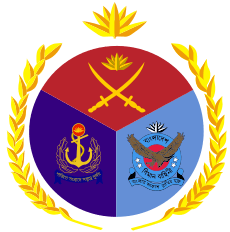Mohammad Abdul Monjur
| Mohammad Abul Monjur | |
|---|---|
| Nickname(s) | Monjur |
| Born |
1940 |
| Died |
2 June 1981 |
| Allegiance |
|
| Service/ |
Pakistan Army Bangladesh Army |
| Rank |
|
| Unit |
Infantry Para Commando |
| Commands held |
Sector – VIII Chief of General Staff GOC 24th Infantry Division |
| Battles/wars | Liberation War of Bangladesh |
| Awards | Bir Uttom |
| Spouse(s) | Rana Yasmeen Manzoor |
| Children | 4 |
Mohammad Abul Monjur, Bir Uttom[1] (1940 - 2 June 1981) was a Bangladesh army general who was a war hero as a freedom fighter and Sector Commander of Mukti Bahini Sector 8 during the Bangladesh Liberation War in 1971.[2] His connection to the murder of President Zia through leading the Coupe is not a proved fact. He was killed shortly after while being captured. About a year later, the military took over the government in a bloodless coup, holding power until 1990.
Monjur had been awarded valor under fire Bir Uttam by the Bangladeshi Government for his bravery in the liberation war. Monjur was appointed as the youngest divisional commander of Bangladesh Army, GOC (General Officer Commanding) of 24th Infantry Division headquartered at Chittagong. His surviving wife and four children were given political asylum in the United States.
Early life
MA Monjur was born at village Gopinathpur under Kasba thana of Comilla district in 1940.[3] His paternal home is at village Kamalpur in Chatkhil thana of Noakhali district. His family moved to East Pakistan after Partition. He passed senior Cambridge in 1955 and ISC examination in 1956 from the Sargoda Public School in Punjab. He was a student of 1st entry (Tempest, Student No 54).
He joined the East Bengal Regiment as a commissioned officer of then East Pakistan. In 1958, he attended Staff College in Canada, where he obtained his PSC. After the Liberation War started, Major Manzoor was a Brigade Major of a Para Commando Brigade close to the Indian border.
He escaped from West Pakistan to India with his family and a few fellow officers.[4] From there, they made their way to Bangladesh, and Manzoor joined up with fellow officers from East Bengal. He quickly became a prominent officer within the ranks and won many battles in his sector. He commanded Sector – VIII during the Liberation War from September 1971 to victory on December 1971.
In 1974-76, he was posted in New Delhi as Military Attache in the Bangladesh Embassy to India. Known for his tenacity, keen eye for strategy, and formation of loyalty from colleagues, in 1975 he was promoted to Colonel.
Upon his return to Dhaka in 1977, he was promoted to Brigadier. In 1980, he was promoted to Major General at the age of 41. He was one of the youngest generals of a front-line force in south-east Asia's history.
Role in assassination of Ziaur Rahman
General Hussain Muhammad Ershad, Chief of Army Staff, transferred General Manzoor to a non-combatant post in Dhaka as Commandant of the Defenece Services Command and Staff College. There is a gossip that Lt Gen Ershad was responsible for the killing of Maj Gen Monjur. But this information is not confirmed. According to Anthony Mascarenhas, Major General Monjur is the sole perpitrator of killing Ziaur Rahman and was shot dead by an agitated nayek subedar of army.
Trial
On 28 February 1995, Abul Mansur the elder brother of General Manzoor filed a murder case with Panchlaish Police Station 14 years after his killing.[2] Jatiya Party Chairman HM Ershad was made the prime accused in the case. Other accused are Maj (retired) Kazi Emdadul Haque, Lt Col (retired) Mostafa Kamaluddin Bhuiyan, Lieutenant Colonel (retired) Shams, and Major General (retired) Adbul Latif.[5][6]
Family and legacy
He left behind his wife and four children.[7][8] They received political asylum in the US. He was considered a war hero as Sector 8 Commander in the Liberation War.[9]
References
- ↑ Bangladesh Gazette of 15 December, 1973; Ministry of Liberation War Affairs
- 1 2 "CID gets 2 more months for Manzoor murder investigation". The Daily Star. 12 March 2015. Retrieved 19 June 2015.
- ↑ Khan, Muazzam Hussain (2012). "Manzoor, Major General Muhammad Abul". In Islam, Sirajul; Jamal, Ahmed A. Banglapedia: National Encyclopedia of Bangladesh (Second ed.). Asiatic Society of Bangladesh.
- ↑ Lifschultz, Lawrence (1979). Bangladesh: The Unfinished Revolution. London: Zed Press. p. 79. ISBN 0-905762-07-X.
[Abu Taher recounting their escape from West Pakistan to join the Bangladesh Liberation War:] Since we had to pass some daylight hours, we went to Major Manzoor's house who was stationed at Sialkot Cantonment. When Manzoor came to know of our plan of escape, he remained quiet and expressed no enthusiasm. At the insistence of his wife, he at last agreed to escape with us. In this way Major Manzoor, his family, and his Bengali batman joined us. At nightfall we drove up to the border, ... walked across the boundary and reached India.
- ↑ Islam Tipu, Md Sanaul (30 May 2013). "Prosecution buying time in Manzoor murder case". Dhaka Tribune. Retrieved 19 June 2015.
- ↑ Islam, Md Sanaul (13 March 2015). "CID gets more time to probe Maj Manzoor murder case". Dhaka Tribune. Retrieved 19 June 2015.
- ↑ "Docket Nos. 03-40052-ag(L), 03-40054-ag(con), 03-40056-ag(con), 03-40058-ag(con). – MANZUR v. DEPARTMENT OF HOMELAND SECURITY – US 2nd Circuit". Caselaw.findlaw.com. Retrieved 17 September 2011.
- ↑ "Manzur v. DHS" (PDF). Archived from the original (PDF) on 1 October 2011.
- ↑ "Sector Commanders Forum". Sector Commanders Forum. 14 April 2008. Archived from the original on 16 August 2011. Retrieved 17 September 2011.
Further reading
- Ali, Tariq. Pakistan: Military Rule or People's Power?, London: Cape, 1970.
